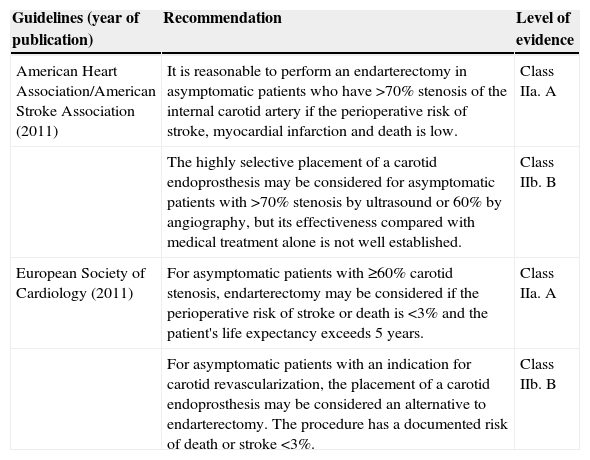Asymptomatic carotid stenosis (ACS) is a common problem in daily clinical practice, and its management is still the subject of controversy. In contrast to symptomatic carotid disease, the main studies on surgical treatment of patients with ACS have shown only a modest benefit in the primary prevention of stroke. In addition, current medical treatment has drastically decreased the risk of stroke in patients with ACS. Selecting patients amenable to endovascular treatment and determining how and when to conduct the ultrasound follow-up of these patients are issues that still need resolving. This article analyzes two new studies underway that provide evidence for better management of ACS in daily clinical practice.
La estenosis carotídea asintomática (ECA) es un problema frecuente en la clínica diaria y su manejo sigue siendo motivo de controversia. Al contrario que en la enfermedad carotídea sintomática, los principales estudios sobre tratamiento quirúrgico de los sujetos con ECA solo han mostrado un beneficio modesto para la prevención primaria del ictus y, además, el tratamiento médico actual ha conseguido disminuir de forma drástica el riesgo de ictus de los sujetos con ECA. La selección de los pacientes subsidiarios de tratamiento endovascular, o cómo y cuándo hacer el seguimiento ecográfico de estos pacientes son cuestiones a resolver. En este artículo se analizan dos nuevos estudios en desarrollo que proporcionarán nuevas evidencias para un mejor manejo de la ECA en la práctica clínica diaria.
Article
Diríjase desde aquí a la web de la >>>FESEMI<<< e inicie sesión mediante el formulario que se encuentra en la barra superior, pulsando sobre el candado.

Una vez autentificado, en la misma web de FESEMI, en el menú superior, elija la opción deseada.

>>>FESEMI<<<







